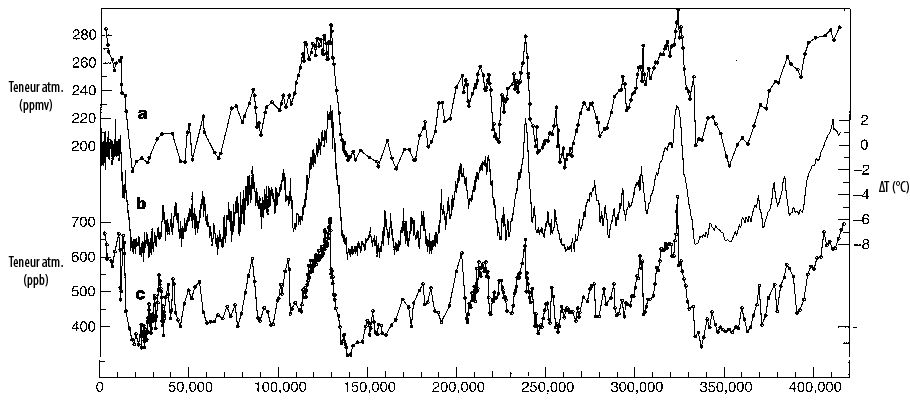A “good surprise” would be, in the circumstances, a process still unknown that would dull the warming induced by our emissions of greenhouse gases.
What do we know exactely ?
The analyses performed on the ice core “archives” show that, over long periods, there is a close correlation between the average temperature and the concentration of the main greenhouse gases :
- CO2,
- CH4

Compared evolutions, over the last 400.000 years (except for the last century, not represented) :
- of the CO2 atmospheric concentration, in parts per million – in short ppmv (upper curve, scale on the upper part of the left vertical axis)
- of the methane (CH4) atmospheric concentration, in parts per billion (lower curve, scale on the lower part of the left vertical axis)
- of the difference between the average surface temperature over Antarctica compared to present (middle curve, scale on the right vertical axis, but is a good marker of the average temperature for the whole planet).
The ice ages correspond to low temperature and CO2 values, and the interglacial ages (like the one we are in right now) correspond to high temperature and CO2 values. Note that between an ice age and a “warm period” the CO2 concentration changes by only 80 ppmv (what is exactely the extra concentration we have just added in a century).
Source : Petit & al., Nature, 1999
It is clear that these three parameters are closely connected. Given the scale of the above figure, and the error range of measures, it is not worth stating that sometimes the temperature “seems” to decrease a little before (or after) CO2 !
These parallel evolutions do not mean by themselves that past climate warmings required an enhanced greenhouse effect to get started. Natural variability for long trends essentially comes from the modification of astronomical parameters: earth-sun distance, tilting of the earth’s axis on the orbit plan, etc, and recent works (2003) suggest that the deglaciation that happened 250.000 years ago did start sith a modification of insolation that in return influenced the CO2 concentration.
But let’s now imagine that there would exist a process that would lead the air near the ground to stop warming up, or to warm much slower, while the CO2 concentration keeps rising at the same rate. Then we should observe, among the above curves, a deconnection between the CO2 curve – in the ascendant parts – and the temperature curve, which means that we should see, at the same time, the CO2 go up while the temperature would do “something else” (remain constant, decrease, or simply rise much slower). Obviously it has not been the case in the past.
Let’s quote Michel PETIT, former vice-head of Ecole Polytechnique, in charge of research activities, and former member of the bureau of the IPCC: “This parallel increase of the CO2 concentration and of the temperature means that it is illusive to rely on a process yet unknown and susceptible to dull the magnitude of the warming induced by the [enhancement of the] greenhouse effect”.